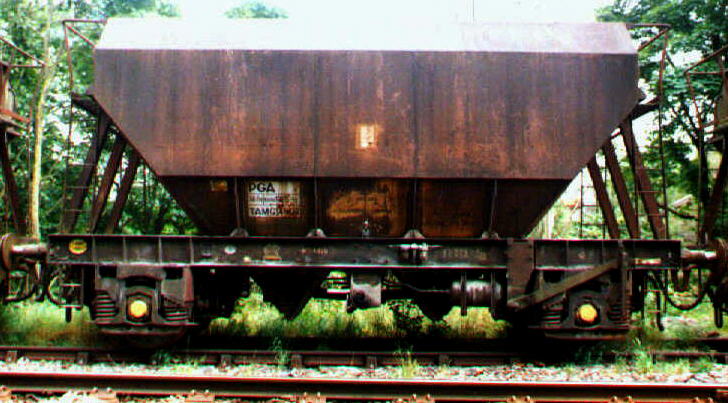
TARMAC PGA STONE WAGONS
Newsflash - January 2006
The wagons are being sent for scrap - I was shocked to see a pair of wagons on the back of a low loader heading north on the A6 Road through Hazel Grove presumably heading for one of the Salford scrapyards. A colleague reported seeing another pair heading the same way a few days later. After almost 15 years of inactivity, Tarmac Central have seemingly decided they no longer require the wagons. More info when available.
 |
Left : PGA TAMC 14907 at Topley Pike during 1999. As can be seen from the condition of the wagon these have not been used since about 1991 with the end of the Carterhouse Lane (Widnes) traffic and the introduction of the RMC JGAs on the Hope Street, Salford and Bletchley flows which these wagons were used along with the Peakstone PGAs. After the services finished the wagons were stored in the loading sidings at Topley Pike until mid-1999 when they were moved and shunted into the headshunt. The line in the foreground is the Buxton - Great Rocks single line with the headshunt line beyond. PG011B; Standard Wagon, Heywood 1979-80; Tare 12.2t; GLW 51t; Gloucester Floating Axle; Brake lever; Range TAMC 14900 - 921 = 22 wagons. |
There was also the prototype wagon RLS 14705 which is basically the same except it had a much simplified end ladder and platform and a single set of discharge doors. PG011A; Standard Wagon, Heywood 1979; Tare 12.6t; GLW 51t; Gloucester Floating Axle; Brake lever. This wagon was scrapped around 1992 but fortunately photos of it do exist.
| Right : TOPS data panel on PGA TAMC 14907 - black writing on white background - most TOPS panels were white on black background. Note also the C Commuted Charge logo now beginning to peel off. This was a scheme whereby the wagon owners paid a charge to the railway company; in this case BR to allow the wagon to be run on their metals. | 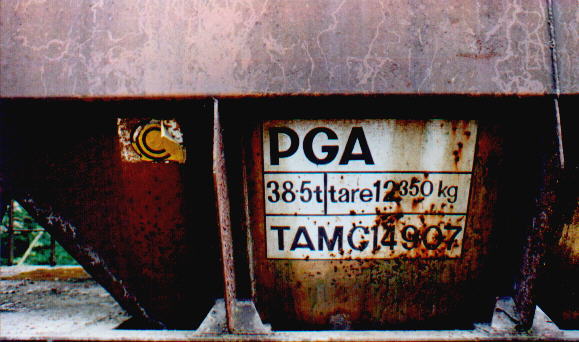 |
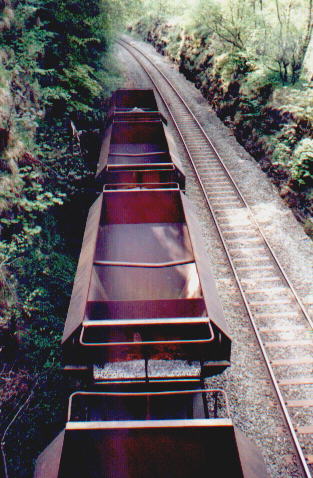 |
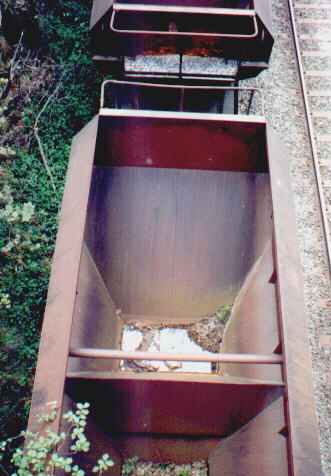 |
| Above Left : The end of the rake of Tarmac PGA wagons as viewed from an occupational overbridge which crosses the line from Great Rocks to Topley Pike thence Buxton. This shows the wagons at the Buxton end of the headshunt at Topley Pike - the wagons were moved from being at the Matlock end of the same headshunt when the new flow of stone from Topley to Pendleton commenced in early 2000. This service uses MEAs and these are generally stored under the stone loader lines or on the Matlock end of the headshunt. | Above Right : A view directly inside one of the PGAs with debris ontop of the hopper doors. Note the centre arch which divides the load into half for unloading purposes. A tubular crossbar strengthens the sides of the wagon. |
| Right : TAMC 14900 the first of the production batch built by Standard Wagon. Note heavy weathering of these wagons and still have lime staining on solebar and ends. All of the wagons are empty. The end inspection platform is at each end of the wagon and the handrails slope outwards on the end of the wagon to provide more working space. |  |
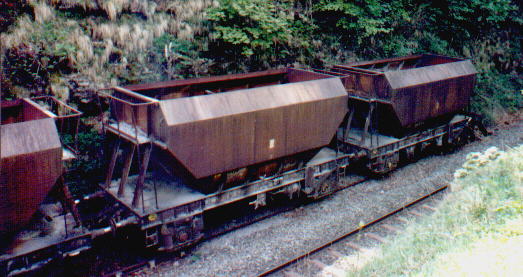 |
Left : L-R TAMC 14900, 909 and 903 at the end of the headshunt. The line in the foreground continues west towards Buxton. |
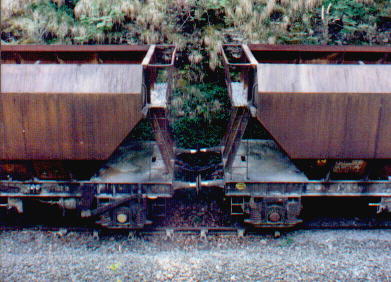
Above : A useful reference view of the wagon ends and the end platforms and handrails. Note how they splay outwards from the platform.
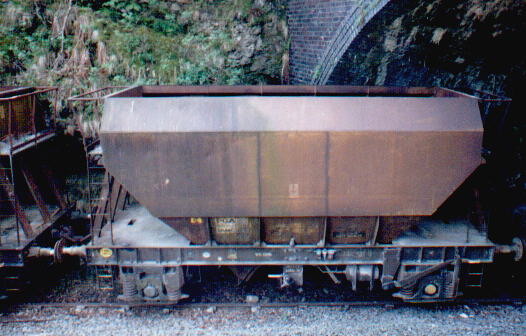
Above : TAMC 14914 just under the aforementioned overbridge. No sign of the RAILEASE lettering that these vehicles once carried on the bodysides. Standard OHLE flash mid-way along bodyside at head height.
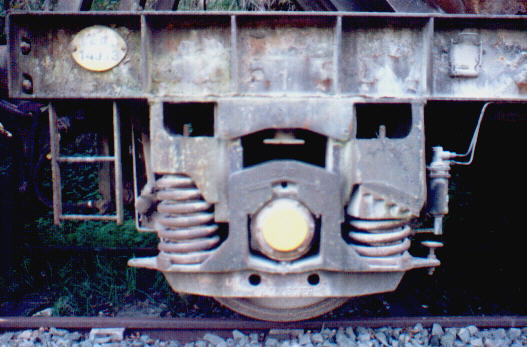 |
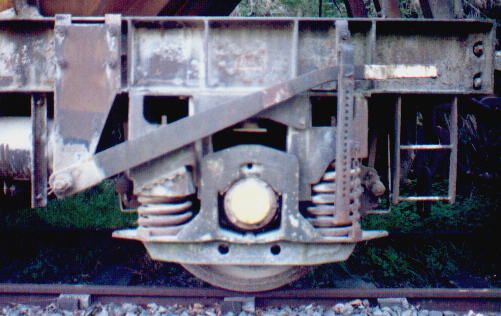 |
| Above Left : The Gloucester Floating Axle suspension unit as fitted to these wagons indeed a vast majority of the 2-Axle Private Owner wagons built during the 1970s and early 1980s. Note the valve on the right of the unit - this acts if the springing of the unit is excessive and when the valve comes into contact with the 'pin-head' below then activates the brakes - I think !! | Above Right : This is the unit as fitted to the right-hand end of the wagon - these units are handed - the difference being the fact that the longer spring always faces the headstocks whilst the 'teeth' face inwards - the 'teeth' is the covering over the inner spring. The right hand unit on these wagons also has the hand-brake lever mounted in front a standard fitting - the levers are fitted at the opposing corners i.e. at right-end of wagon. All wagons have clasp brakes and plain disk wheelsets. |
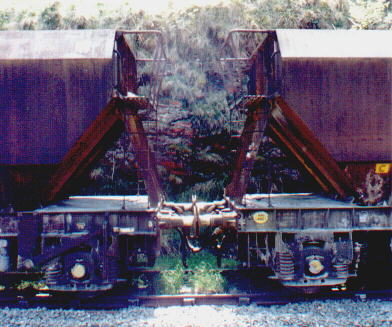 |
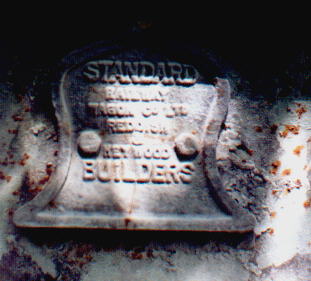 |
| Above Left : Ends of the wagons showing how the handrails slope outwards and buffing details. Wagons have two brake pipes - one Yellow and one Red - only the Red pipe is connected as this is the train air pipe. Instanter couplings are fitted to all wagons. | Above Right : A close up of the Standard Railway Wagon Co Ltd builders plate. Also reads Reddish & Heywood Builders. It is a bell shaped plate affixed by the two bolts seen above. |
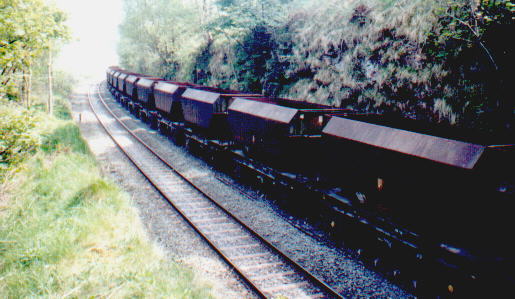
Above : A view of the remaining wagons looking towards the Tarmac sidings at Topley Pike @ 1/4 mile round the curve. The line in the foregound is the single line to/from Buxton. This was relaid using steel sleepers during 1993 after one of the Tunstead - Hindlow limestone trains derailed on this single line section blocking the route. The line was action for a few weeks maybe even a month until re-opened. As the Hindlow runs almost on a daily basis the services were diverted as follows - Tunstead - Peak Forest - Chinley - New Mills South - Romiley - Guide Bridge - Stockport - Hazel Grove - Furness Vale - Buxton - Hindlow and return. The outward journey would be able to run directly onto the Hindlow branch but the return working would have had to go into Donarue sidings and reverse into the station before being able to take the Down line to Stockport.
I am currently modelling these wagons in 4mm scale making prototype wagon RLS 14705 and the 22 production wagons TAMC 14900-921 using Hornby PGA underframes and scratchbuilt plasticard bodies. The underframes are shortened by 4mm to obtain the correct length and wheelbase. Hopefully this rake will be seen on my planned Peak District model layout or Hazel Valley owned by the HG&DMRS.